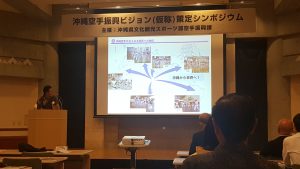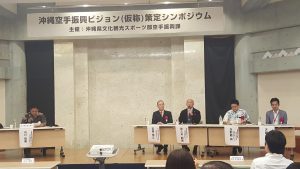Okinawa Karate promotion vision symposium
During the fiscal year 2017, the Okinawa Prefecture Government is formulating the “Okinawa Karate Promotion Vision (tentative name)”, which describes the future image that Okinawa karate should aim for. In order to prepare a gist draft of the vision, three examination groups have already held 3 meetings and 2 others are scheduled.
Three symposiums are also planned to promote the project to the general public. On October 31st, the first symposium was held at the Okinawa Convention Center and some 70 people attend the event.
In the first part, Mr. Yamakawa Tetsuo, head of the Okinawa Prefectural Karate Promotion Division, concisely explained the current situation of Okinawa karate and the issues it faces. He went on explaining that Okinawa karate’s preservation, succession, and development for the future must be planned strategically, with 3 steps that are to share common knowledge and understanding, followed by a stage of formulating the Okinawa karate promotion vision (provisional name), finally topped by the formulation of a roadmap of the promotion vision. Mr. Yamakawa stressed that the aim is to promote Okinawa karate with all related parties becoming and acting as one. Here is the brochure handed during the symposium (in Japanese).
The second half of the evening was a panel discussion let by Mr. Yamakawa. The four panelists were: karate expert and historian Miyagi Tokumasa, former kata champion and head of Ryūei-ryū Ryūhō-kai Sakumoto Tsuguo, OPG Superintendent for industrial promotion Tamanaha Yasushi and Tengan Ryō, section chief of Okinawa City’s Tourism Promotion Division. The three first panelists are heading the three examination groups discussing the pillars of the promotion vision that are “Preservation and Succession”, “Promotion and Public awareness” and “Promotion and Development”.
Mr. Miyagi said that it is important to reconfirm that prefectural people see karate as a traditional culture of Okinawa. It is crucial to investigate fundamental matters and make Okinawans conscious of karate’s value. He also stressed that people must be enlighten with the fact that “karate is not only for oneself but for the society”.
Mr. Sakumoto offered a few ideas considered in his committee: Although it is difficult to unify styles, how about unifying basic bunkai (kata applications); how about electing leaders for each country like a karate ambassador system; better collaboration between schools and downtown dojo; traditional karate and sport karate shouldn’t be in opposition but form a coalition; the strengthening of organizational structure and cooperation with outside entities.
Mr. Tamanaha believes that the karate related industry is still immature and should be supported. Therefore, he introduced the three pillars proposed and examined by the study group he leads: 1. Quality control centered on a license system, 2. Protection and utilization of rights through licensing, 3. Dojo management support and guidance.
Mr. Sakumoto went on explaining that there are many needs in regards to karate and that karate should answer each one of these needs. It can be karate practice for health, or karate practice as a mean of social exchanges. Karate should also be a way for an athlete to develop a career as a player, and allow someone to live from karate if he/she choose to become a professional. Having chosen a professional path, Mr. Sakumoto and his students have started a general foundation corporation that is directed by 5 directors, counts 12 dojo and has 600 members who pay a registration fee.
He strongly expressed that choosing to be a professional in karate is not about making millions. Yet, one should be able to build an environment that will support a family, allow children to have a good education and live a good life as a karate instructor.
An idea man, Mr. Tamanaha said that he envisions to develop future karate projects through a cooperative type organization.
At the end of the evening, various questions were raised from the floor, many of them relating to education. With martial art being a required curriculum in junior and senior high schools, 80% of junior high schools and 60% of senior high schools in the prefecture have chosen karate. A great guide for instructing karate was also published (link in Japanese). From now on, the OPG and concerned parties must consider how karate could be incorporated in prefectural elementary schools.
The next symposium is scheduled for December 19th at the Okinawa Karate Kaikan.


